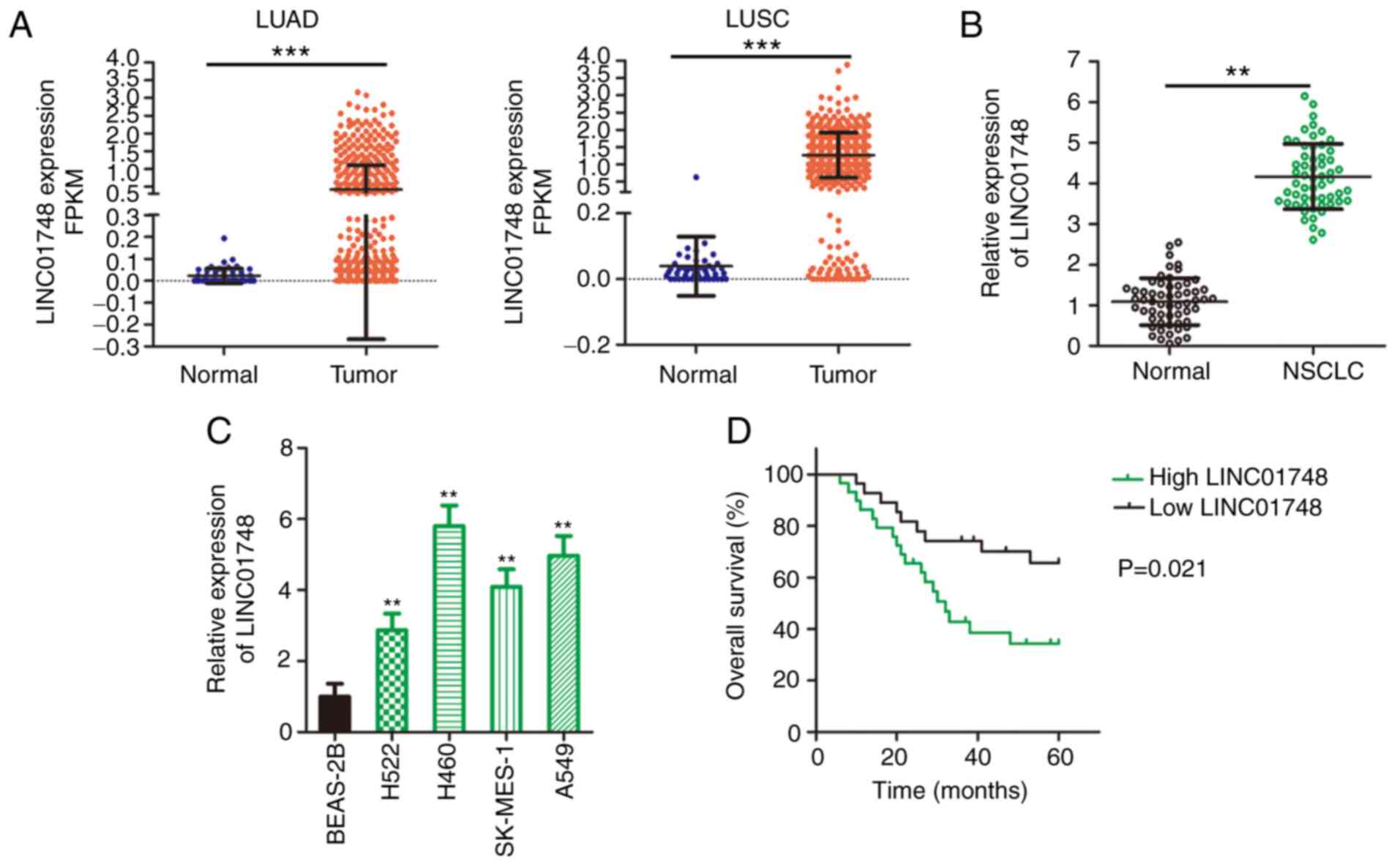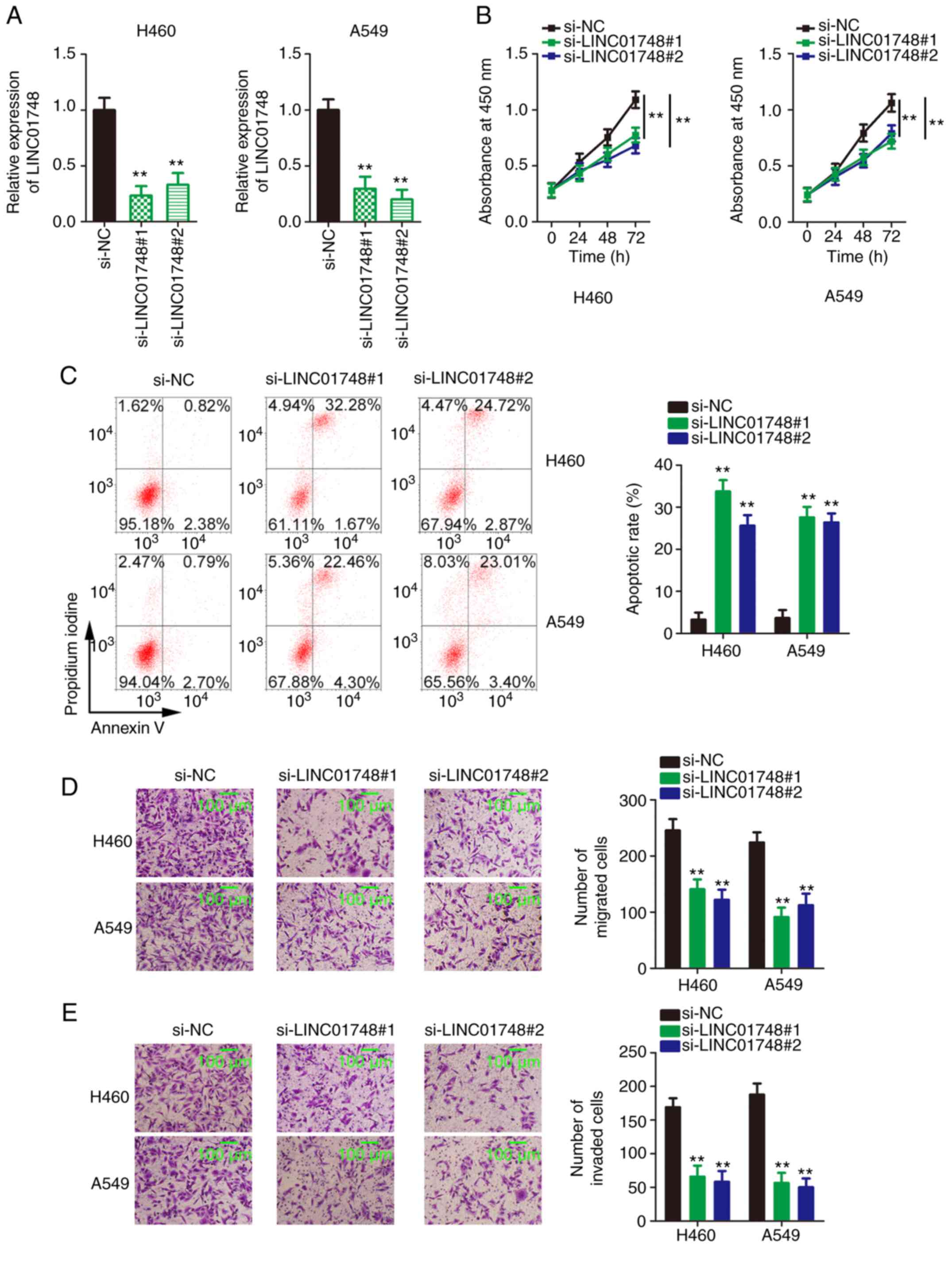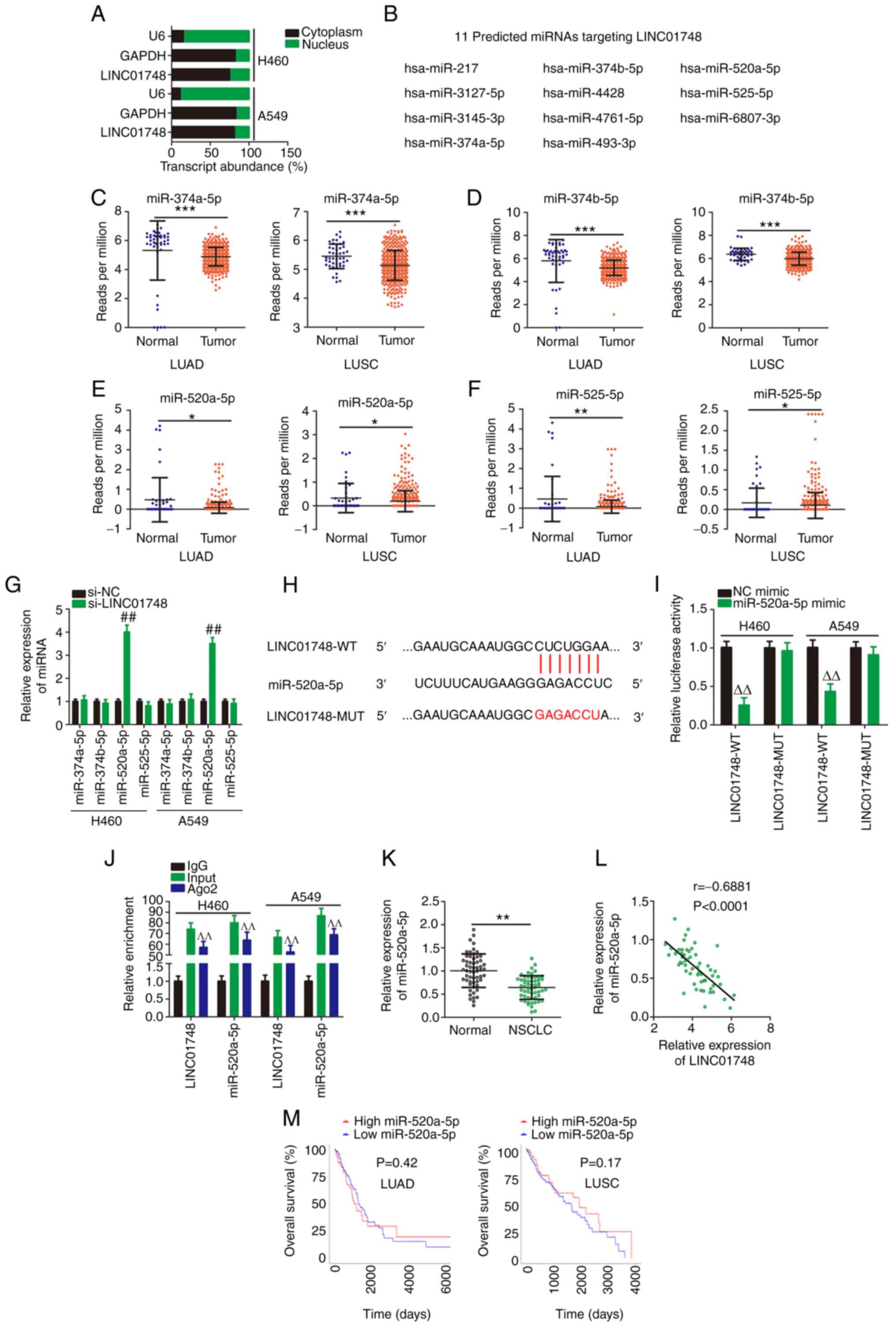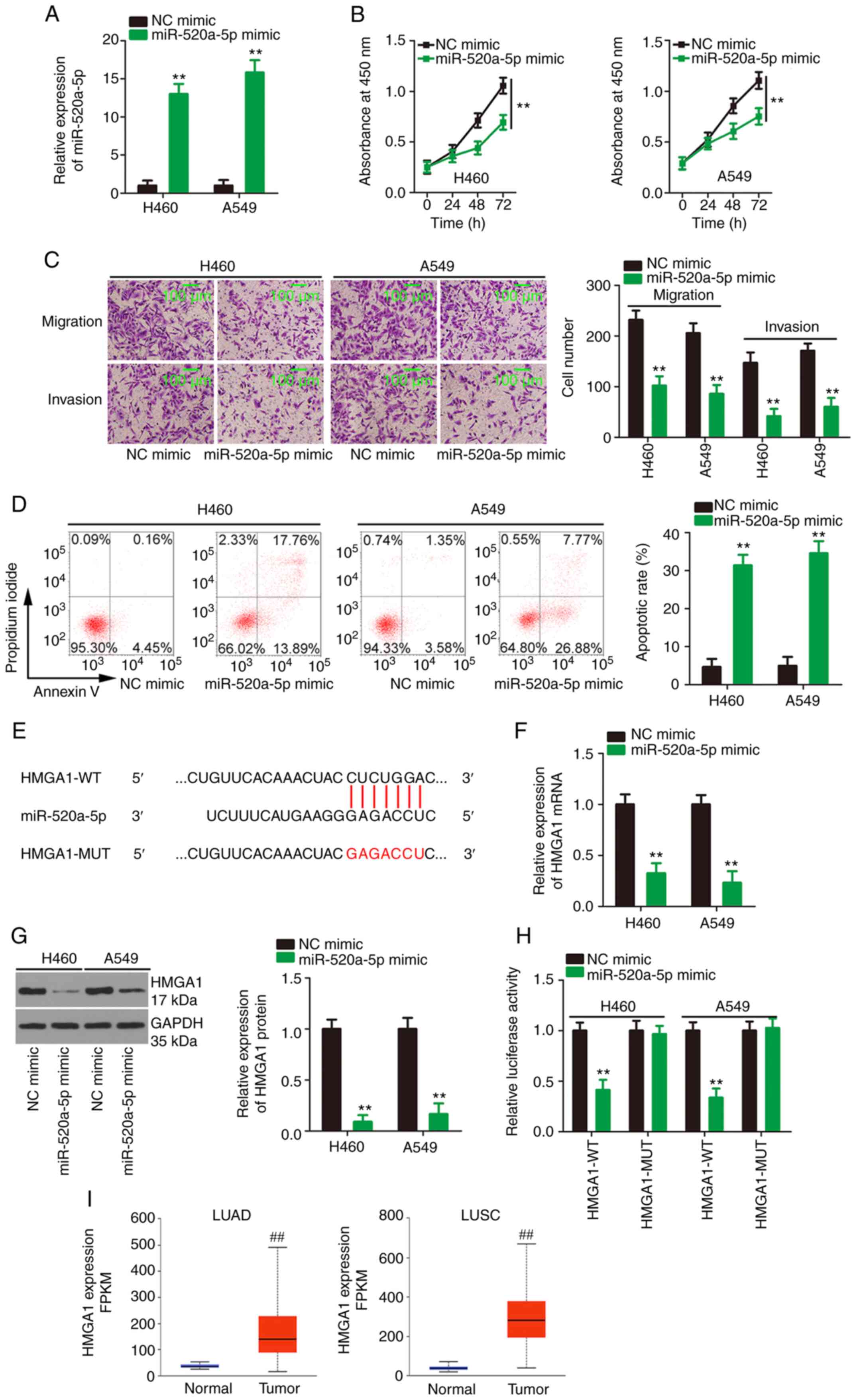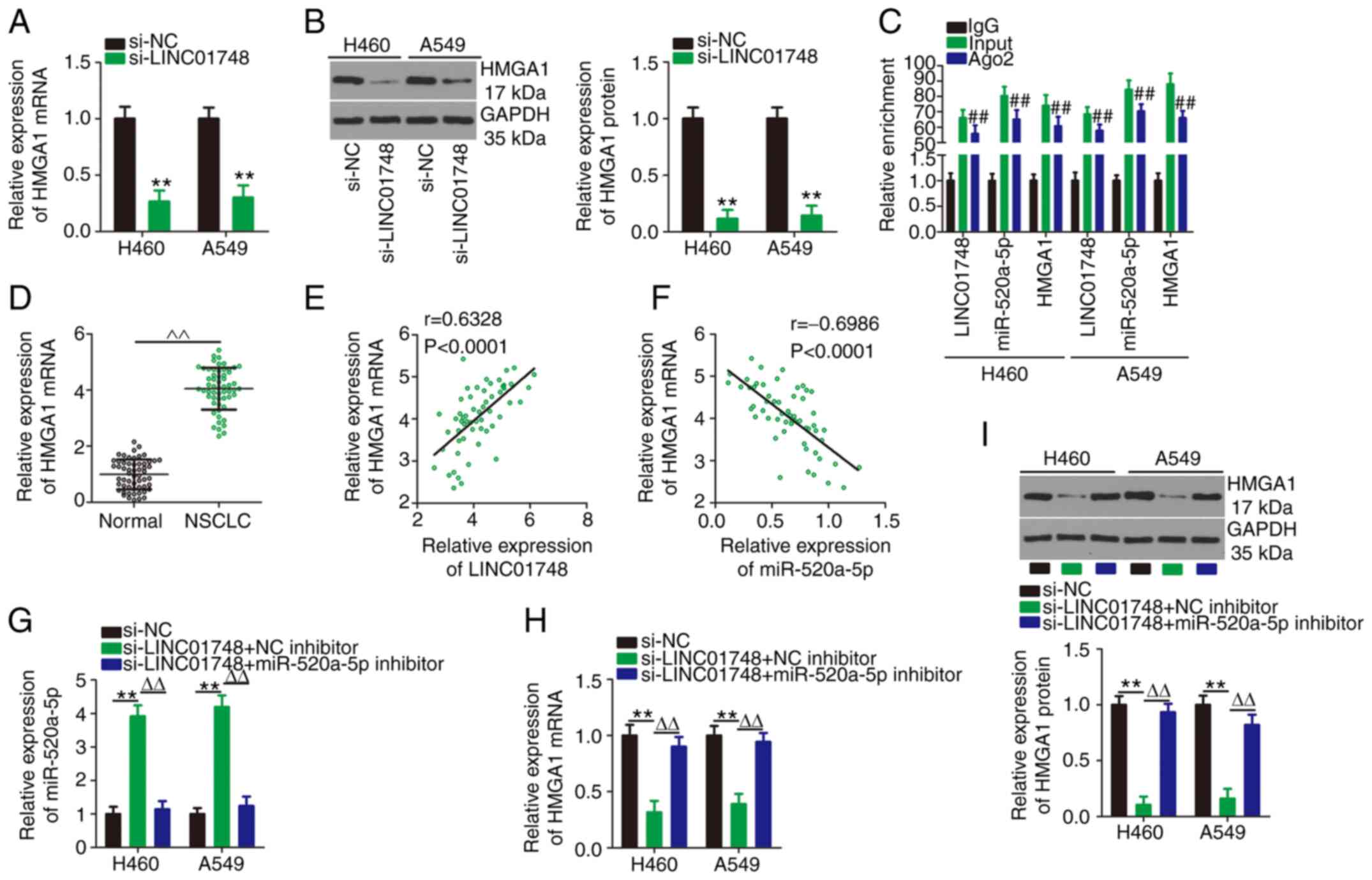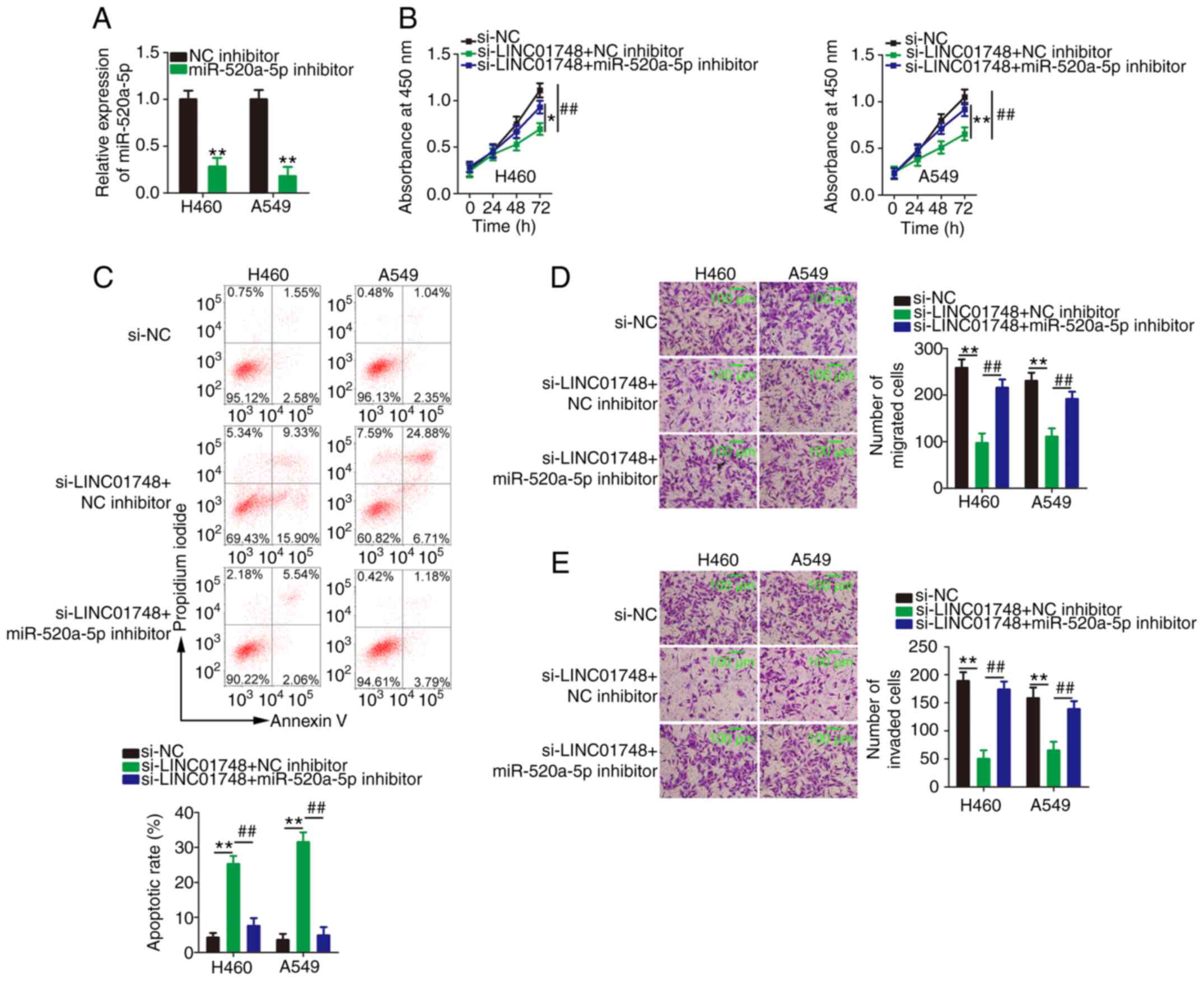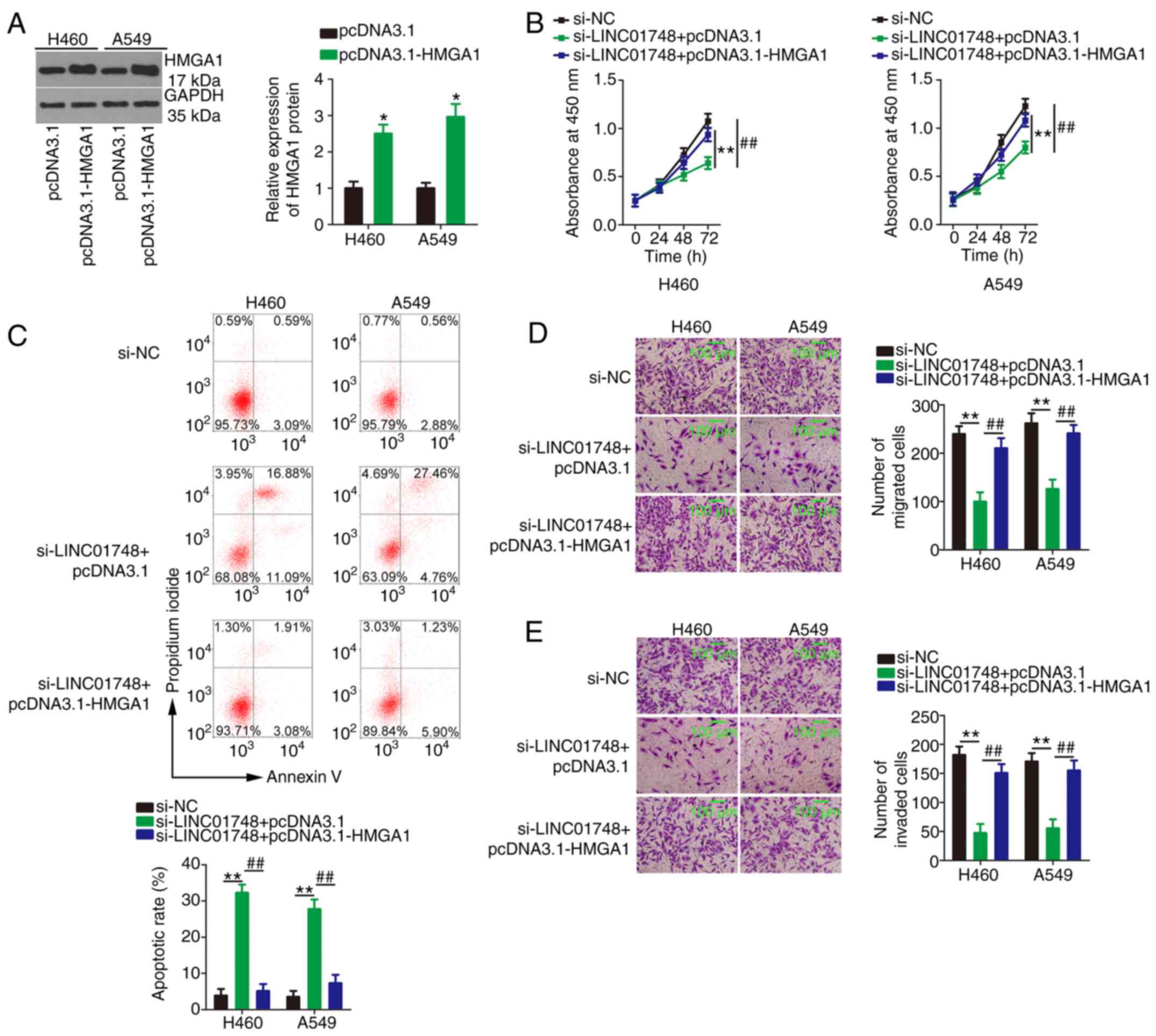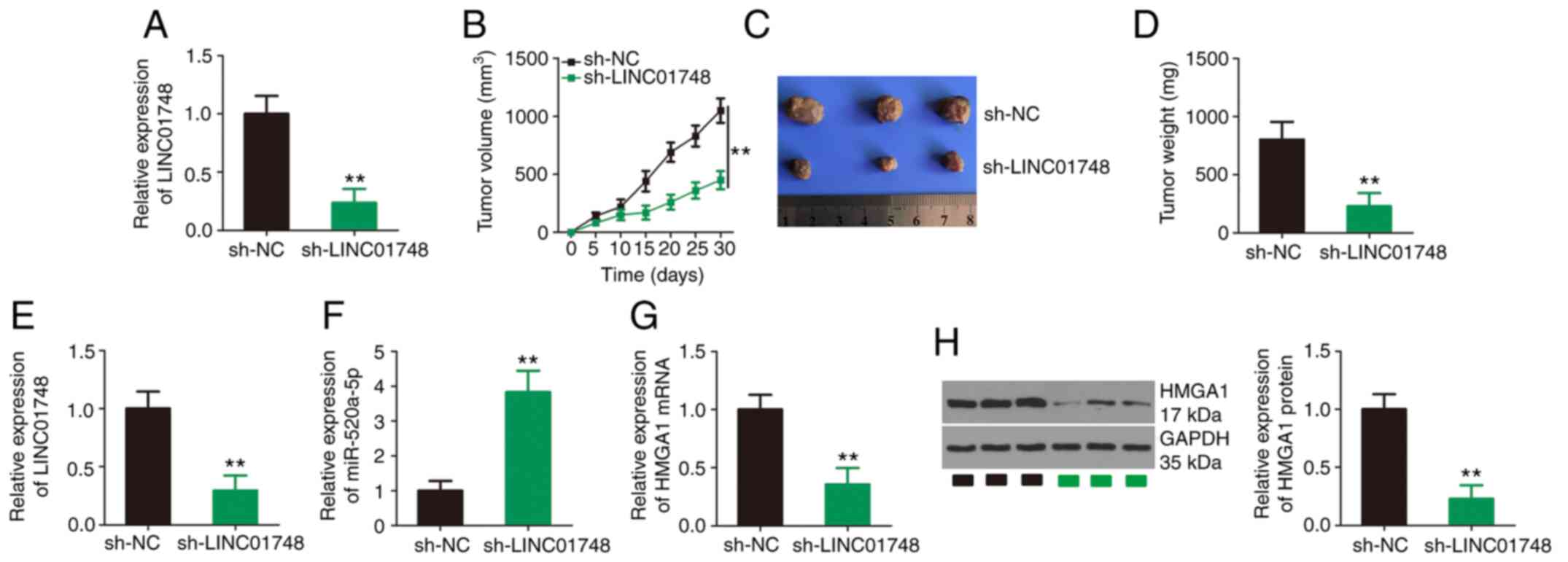|
1
|
Siegel RL, Miller KD and Jemal A: Cancer
statistics, 2020. CA Cancer J Clin. 70:7–30. 2020. View Article : Google Scholar : PubMed/NCBI
|
|
2
|
Bray F, Ferlay J, Soerjomataram I, Siegel
RL, Torre LA and Jemal A: Global cancer statistics 2018: GLOBOCAN
estimates of incidence and mortality worldwide for 36 cancers in
185 countries. CA Cancer J Clin. 68:394–424. 2018. View Article : Google Scholar : PubMed/NCBI
|
|
3
|
Travis WD: Lung cancer pathology: Current
concepts. Clin Chest Med. 41:67–85. 2020. View Article : Google Scholar : PubMed/NCBI
|
|
4
|
Lemjabbar-Alaoui H, Hassan OU, Yang YW and
Buchanan P: Lung cancer: Biology and treatment options. Biochim
Biophys Acta. 1856:189–210. 2015.PubMed/NCBI
|
|
5
|
Herbst RS, Morgensztern D and Boshoff C:
The biology and management of non-small cell lung cancer. Nature.
553:446–454. 2018. View Article : Google Scholar : PubMed/NCBI
|
|
6
|
de Mello RA, Neves NM, Tadokoro H, Amaral
GA, Castelo-Branco P and Zia VAA: New target therapies in advanced
non-small cell lung cancer: A review of the literature and future
perspectives. J Clin Med. 9:35432020. View Article : Google Scholar :
|
|
7
|
Alexander M, Kim SY and Cheng H: Update
2020: Management of non-small cell lung cancer. Lung. 198:897–907.
2020. View Article : Google Scholar : PubMed/NCBI
|
|
8
|
Duma N, Santana-Davila R and Molina JR:
Non-small cell lung cancer: Epidemiology, screening, diagnosis, and
treatment. Mayo Clin Proc. 94:1623–1640. 2019. View Article : Google Scholar : PubMed/NCBI
|
|
9
|
Batista PJ and Chang HY: Long noncoding
RNAs: Cellular address codes in development and disease. Cell.
152:1298–1307. 2013. View Article : Google Scholar : PubMed/NCBI
|
|
10
|
Bhan A, Soleimani M and Mandal SS: Long
noncoding RNA and cancer: A new paradigm. Cancer Res. 77:3965–3981.
2017. View Article : Google Scholar : PubMed/NCBI
|
|
11
|
Qin T, Li J and Zhang KQ: Structure,
regulation, and function of linear and circular long non-coding
RNAs. Front Genet. 11:1502020. View Article : Google Scholar : PubMed/NCBI
|
|
12
|
He RZ, Luo DX and Mo YY: Emerging roles of
lncRNAs in the post-transcriptional regulation in cancer. Genes
Dis. 6:6–15. 2019. View Article : Google Scholar : PubMed/NCBI
|
|
13
|
Gao T and Ji Y: Long noncoding RNA
LINC00707 accelerates tumorigenesis and progression of bladder
cancer via targeting miR-145/CDCA3 regulatory loop. Urol Int. Jun
30–2021.Epub ahead of print. View Article : Google Scholar
|
|
14
|
Cao S, Li H and Li L: LncRNA SNHG17
contributes to the progression of cervical cancer by targeting
microRNA-375-3p. Cancer Manag Res. 13:4969–4978. 2021. View Article : Google Scholar : PubMed/NCBI
|
|
15
|
Wang S, Han H, Meng J, Yang W, Lv Y and
Wen X: Long non-coding RNA SNHG1 suppresses cell migration and
invasion and upregulates SOCS2 in human gastric carcinoma. Biochem
Biophys Rep. 27:1010522021.PubMed/NCBI
|
|
16
|
Xu J, Wang J, He Z, Chen P, Jiang X, Chen
Y, Liu X and Jiang J: LncRNA CERS6-AS1 promotes proliferation and
metastasis through the upregulation of YWHAG and activation of ERK
signaling in pancreatic cancer. Cell Death Dis. 12:6482021.
View Article : Google Scholar : PubMed/NCBI
|
|
17
|
Wan Y, Yao D, Fang F, Wang Y, Wu G and
Qian Y: LncRNA WT1-AS downregulates lncRNA UCA1 to suppress
non-small cell lung cancer and predicts poor survival. BMC Cancer.
21:1042021. View Article : Google Scholar : PubMed/NCBI
|
|
18
|
Lin JH, Chen FN, Wu CX, Hu SQ and Ma J:
Long non-coding RNA B4GALT1-Antisense RNA 1/microRNA-30e/SRY-box
transcription factor 9 signaling axis contributes to non-small cell
lung cancer cell growth. Oncol Lett. 20:2842020. View Article : Google Scholar : PubMed/NCBI
|
|
19
|
Pang L, Zhang Q, Wu Y, Yang Q, Zhang J,
Liu Y and Li R: Long non-coding RNA CCAT1 promotes non-small cell
lung cancer progression by regulating the miR-216a-5p/RAP2B axis.
Exp Biol Med (Maywood). 246:142–152. 2021. View Article : Google Scholar
|
|
20
|
Ye R, Tang R, Gan S, Li R, Cheng Y, Guo L,
Zeng C and Sun Y: New insights into long non-coding RNAs in
non-small cell lung cancer. Biomed Pharmacother. 131:1107752020.
View Article : Google Scholar : PubMed/NCBI
|
|
21
|
Calin GA and Croce CM: MicroRNA signatures
in human cancers. Nat Rev Cancer. 6:857–866. 2006. View Article : Google Scholar : PubMed/NCBI
|
|
22
|
Guo H, Ingolia NT, Weissman JS and Bartel
DP: Mammalian microRNAs predominantly act to decrease target mRNA
levels. Nature. 466:835–840. 2010. View Article : Google Scholar : PubMed/NCBI
|
|
23
|
Castro D, Moreira M, Gouveia AM, Pozza DH
and De Mello RA: MicroRNAs in lung cancer. Oncotarget.
8:81679–81685. 2017. View Article : Google Scholar : PubMed/NCBI
|
|
24
|
Zang H, Wang W and Fan S: The role of
microRNAs in resistance to targeted treatments of non-small cell
lung cancer. Cancer Chemother Pharmacol. 79:227–231. 2017.
View Article : Google Scholar
|
|
25
|
Florczuk M, Szpechcinski A and
Chorostowska-Wynimko J: MiRNAs as biomarkers and therapeutic
targets in non-small cell lung cancer: Current perspectives. Target
Oncol. 12:179–200. 2017. View Article : Google Scholar : PubMed/NCBI
|
|
26
|
Salmena L, Poliseno L, Tay Y, Kats L and
Pandolfi PP: A ceRNA hypothesis: The Rosetta stone of a hidden RNA
language? Cell. 146:353–358. 2011. View Article : Google Scholar : PubMed/NCBI
|
|
27
|
Fu Y, Liu L, Zhan J, Zhan H and Qiu C:
LncRNA GAS5 expression in non-small cell lung cancer tissues and
its correlation with Ki67 and EGFR. Am J Transl Res. 13:4900–4907.
2021.PubMed/NCBI
|
|
28
|
Jia D, Xing Y, Zhan Y, Cao M, Tian F, Fan
W, Huang J, Cui Y, Gu R, Cui Y, et al: LINC02678 as a novel
prognostic marker promotes aggressive non-small-cell lung cancer.
Front Cell Dev Biol. 9:6869752021. View Article : Google Scholar : PubMed/NCBI
|
|
29
|
Zhang L, Chi B, Chai J, Qin L, Zhang G,
Hua P and Jin C: LncRNA CCDC144NL-AS1 serves as a prognosis
biomarker for non-small cell lung cancer and promotes cellular
function by targeting miR-490-3p. Mol Biotechnol. Jun 11–2021.Epub
ahead of print. View Article : Google Scholar
|
|
30
|
Livak KJ and Schmittgen TD: Analysis of
relative gene expression data using real-time quantitative PCR and
the 2(-Delta Delta C(T)) method. Methods. 25:402–408. 2001.
View Article : Google Scholar
|
|
31
|
Sarhadi VK, Wikman H, Salmenkivi K, Kuosma
E, Sioris T, Salo J, Karjalainen A, Knuutila S and Anttila S:
Increased expression of high mobility group A proteins in lung
cancer. J Pathol. 209:206–212. 2006. View Article : Google Scholar : PubMed/NCBI
|
|
32
|
Cao YD, Huang PL, Sun XC, Ma J, Jin ZL,
Cheng HY, Xu RZ, Li F, Qin SK, Deng YX and Ge XL: Silencing of high
mobility group A1 enhances gemcitabine chemosensitivity of lung
adenocarcinoma cells. Chin Med J (Engl). 124:1061–1068. 2011.
|
|
33
|
Zhang Z, Wang Q, Chen F and Liu J:
Elevated expression of HMGA1 correlates with the malignant status
and prognosis of non-small cell lung cancer. Tumour Biol.
36:1213–1219. 2015. View Article : Google Scholar
|
|
34
|
Ma Y, Li X, Chen S, Du B and Li Y:
MicroRNA-4458 suppresses migration and epithelial-mesenchymal
transition via targeting HMGA1 in non-small-cell lung cancer cells.
Cancer Manag Res. 11:637–649. 2019. View Article : Google Scholar : PubMed/NCBI
|
|
35
|
Peng W, Wang J, Shan B, Peng Z, Dong Y,
Shi W, He D, Cheng Y, Zhao W, Zhang C, et al: Diagnostic and
prognostic potential of circulating long non-coding RNAs in non
small cell lung cancer. Cell Physiol Biochem. 49:816–827. 2018.
View Article : Google Scholar : PubMed/NCBI
|
|
36
|
Lu T, Wang Y, Chen D, Liu J and Jiao W:
Potential clinical application of lncRNAs in non-small cell lung
cancer. Onco Targets Ther. 11:8045–8052. 2018. View Article : Google Scholar : PubMed/NCBI
|
|
37
|
Fang C, Wang L, Gong C, Wu W, Yao C and
Zhu S: Long non-coding RNAs: How to regulate the metastasis of
non-small-cell lung cancer. J Cell Mol Med. 24:3282–3291. 2020.
View Article : Google Scholar : PubMed/NCBI
|
|
38
|
Chen J, Wang R, Zhang K and Chen LB: Long
non-coding RNAs in non-small cell lung cancer as biomarkers and
therapeutic targets. J Cell Mol Med. 18:2425–2436. 2014. View Article : Google Scholar : PubMed/NCBI
|
|
39
|
Zhan Y, Zang H, Feng J, Lu J, Chen L and
Fan S: Long non-coding RNAs associated with non-small cell lung
cancer. Oncotarget. 8:69174–69184. 2017. View Article : Google Scholar : PubMed/NCBI
|
|
40
|
Wang L, Ma L, Xu F, Zhai W, Dong S, Yin L,
Liu J and Yu Z: Role of long non-coding RNA in drug resistance in
non-small cell lung cancer. Thorac Cancer. 9:761–768. 2018.
View Article : Google Scholar : PubMed/NCBI
|
|
41
|
Zhao MM, Ge LY, Yang LF, Zheng HX, Chen G,
Wu LZ, Shi SM, Wang N and Hang YP: LncRNA NEAT1/miR-204/NUAK1 Axis
is a potential therapeutic target for non-small cell lung cancer.
Cancer Manag Res. 12:13357–13368. 2020. View Article : Google Scholar
|
|
42
|
Guo K, Qi D and Huang B: LncRNA MEG8
promotes NSCLC progression by modulating the
miR-15a-5p-miR-15b-5p/PSAT1 axis. Cancer Cell Int. 21:842021.
View Article : Google Scholar : PubMed/NCBI
|
|
43
|
Wang S, Wang T, Liu D and Kong H: LncRNA
MALAT1 aggravates the progression of non-small cell lung cancer by
stimulating the expression of COMMD8 via targeting miR-613. Cancer
Manag Res. 12:10735–10747. 2020. View Article : Google Scholar : PubMed/NCBI
|
|
44
|
Wang J, Shu HZ, Xu CY and Guo SG: LncRNA
DGCR5 promotes non-small cell lung cancer progression via sponging
miR-218-5p. Eur Rev Med Pharmacol Sci. 24:103032020.PubMed/NCBI
|
|
45
|
Li J, Wu X, Cao W and Zhao J: Long
non-coding RNA NCK1-AS1 promotes the proliferation, migration and
invasion of non-small cell lung cancer cells by acting as a ceRNA
of miR-137. Am J Transl Res. 12:6908–6920. 2020.PubMed/NCBI
|
|
46
|
Zhang D, Cai X, Cai S, Chen W and Hu C:
Long intergenic non-protein coding RNA 01089 weakens tumor
proliferation, migration, and invasion by sponging miR-3187-3p in
non-small cell lung cancer. Cancer Manag Res. 12:12151–12162. 2020.
View Article : Google Scholar : PubMed/NCBI
|
|
47
|
Li X, Lv F, Li F, Du M, Liang Y, Ju S, Liu
Z, Zhou B, Wang B and Gao Y: LINC01089 inhibits tumorigenesis and
epithelial-mesenchymal transition of non-small cell lung cancer via
the miR-27a/SFRP1/Wnt/β-catenin axis. Front Oncol. 10:5325812020.
View Article : Google Scholar
|
|
48
|
Yan F, Zhao W, Xu X, Li C, Li X, Liu S,
Shi L and Wu Y: LncRNA DHRS4-AS1 inhibits the stemness of NSCLC
cells by sponging miR-224-3p and upregulating TP53 and TET1. Front
Cell Dev Biol. 8:5852512020. View Article : Google Scholar
|
|
49
|
Qi X, Zhang DH, Wu N, Xiao JH, Wang X and
Ma W: ceRNA in cancer: Possible functions and clinical
implications. J Med Genet. 52:710–718. 2015. View Article : Google Scholar : PubMed/NCBI
|
|
50
|
Wang L, Cho KB, Li Y, Tao G, Xie Z and Guo
B: Long noncoding RNA (lncRNA)-mediated competing endogenous RNA
networks provide novel potential biomarkers and therapeutic targets
for colorectal cancer. Int J Mol Sci. 20:57582019. View Article : Google Scholar :
|
|
51
|
Kaymaz BT, Cetintas VB, Aktan C and Kosova
B: MicroRNA-520a-5p displays a therapeutic effect upon chronic
myelogenous leukemia cells by targeting STAT3 and enhances the
anticarcinogenic role of capsaicin. Tumour Biol. 35:8733–8742.
2014. View Article : Google Scholar : PubMed/NCBI
|
|
52
|
Liu X, Song J, Kang Y, Wang Y and Chen A:
Long noncoding RNA SOX21-AS1 regulates the progression of
triple-negative breast cancer through regulation of
miR-520a-5p/ORMDL3 axis. J Cell Biochem. 121:4601–4611. 2020.
View Article : Google Scholar : PubMed/NCBI
|
|
53
|
Xu X, Tao R, Sun L and Ji X:
Exosome-transferred hsa_circ_0014235 promotes DDP chemoresistance
and deteriorates the development of non-small cell lung cancer by
mediating the miR-520a-5p/CDK4 pathway. Cancer Cell Int.
20:5522020. View Article : Google Scholar : PubMed/NCBI
|
|
54
|
Jin M, Shi C, Hua Q, Li T, Yang C, Wu Y,
Zhao L, Yang H, Zhang J, Hu C and Huang G: High circ-SEC31A
expression predicts unfavorable prognoses in non-small cell lung
cancer by regulating the miR-520a-5p/GOT-2 axis. Aging (Albany NY).
12:10381–10397. 2020. View Article : Google Scholar
|
|
55
|
Liu H, Zhang X, Jin X, Yang Y, Liang G, Ma
Y and Wang B: Long Noncoding RNA VPS9D1-AS1 Sequesters
microRNA-525-5p to promote the oncogenicity of colorectal cancer
cells by upregulating HMGA1. Cancer Manag Res. 12:9915–9928. 2020.
View Article : Google Scholar : PubMed/NCBI
|
|
56
|
Huang B, Chang C, Wang BL and Li H:
ELK1-induced upregulation of lncRNA TRPM2-AS promotes tumor
progression in gastric cancer by regulating miR-195/HMGA1 axis. J
Cell Biochem. 120:16921–16933. 2019. View Article : Google Scholar : PubMed/NCBI
|















